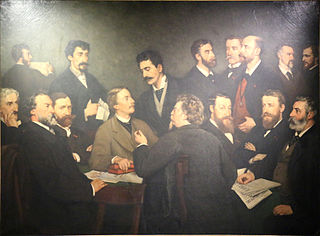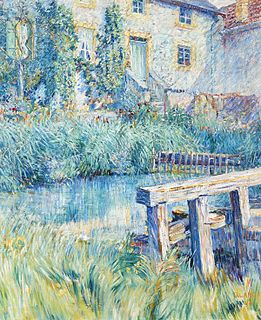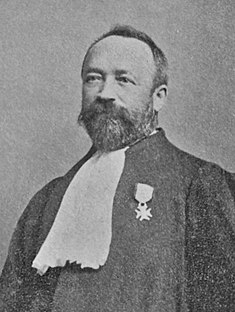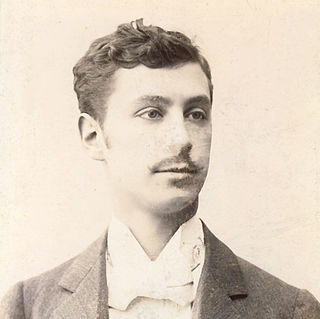Related Research Articles

Tachisme is a French style of abstract painting popular in the 1940s and 1950s. The term is said to have been first used with regards to the movement in 1951. It is often considered to be the European equivalent to abstract expressionism, although there are stylistic differences. It was part of a larger postwar movement known as Art Informel, which abandoned geometric abstraction in favour of a more intuitive form of expression, similar to action painting. Another name for Tachism is Abstraction lyrique. COBRA is also related to Tachisme, as is Japan's Gutai group.

The culture of Luxembourg refers to the cultural life and traditions of Luxembourg. Most citizens are trilingual, speaking French and German in addition to the Germanic national language of Luxembourgish. Although its contributions to the arts are not largely known outside its borders, Luxembourg has a rich cultural history, especially in music, painting and photography. Its evolving museums, concert halls, theatres and galleries testify to its citizens' growing appreciation of culture.
The Prix Grand-Duc Adolphe is a Luxembourgian art award awarded every year to one or more artists exhibiting at the Salon Artistique of the Cercle artistique de Luxembourg (CAL).

The Société Libre des Beaux-Arts was an organization formed in 1868 by Belgian artists to react against academicism and to advance Realist painting and artistic freedom. Based in Brussels, the society was active until 1876, by which time the aesthetic values it espoused had infiltrated the official Salon. It played a formative role in establishing avant-gardism in Belgium.

Michel Mimran is a French architect, artist and member of the artistic circle of Luxembourg. He's been actively working around the subject of perception and memory.
Emile Kirscht (1913–1994) was a Luxembourg painter who worked with acrylics and gouache on paper. In 1954, he was a co-founder of the Iconomaques group of abstract artists in Luxembourg.
Michel Stoffel (1903–1963) was a Luxembourg artist and author. He also worked for a time in the insurance sector. Together with Joseph Kutter, he is considered to be one of Luxembourg's most prominent painters.

Nico Klopp (1894–1930) was a Luxembourg painter remembered above all for his post-impressionist paintings of scenes on the River Moselle where he lived.

Dominique Lang (1874–1919) is considered to be Luxembourg's most important Impressionist painter. He painted both portraits and landscapes although he was employed as a high-school teacher.

Michel Engels (1851–1901) was a Luxembourg illustrator, painter and art teacher who is remembered principally for his sketches of the fortifications of Luxembourg City and for cofounding the Cercle artistique de Luxembourg.

Luxembourg art can be traced back to Roman times, especially as depicted in statues found across the country and in the huge mosaic from Vichten. Over the centuries, Luxembourg's churches and castles have housed a number of cultural artefacts but these are nearly all ascribed to foreign artists. The first examples of art with a national flavour are paintings and maps of the City of Luxembourg and its fortifications from the end of the 16th until the beginning of the 19th century, although these too were mostly created by foreign artists. Real interest in art among the country's own citizens began in the 19th century with paintings of Luxembourg and the surroundings after the country became a grand duchy in 1815. This was followed by interest in Impressionism and Expressionism in the early 20th century, the richest period in Luxembourg painting, while Abstraction became the focus of art after the Second World War. Today there are a number of successful contemporary artists, some of whom have gained wide international recognition.
The Salon de la Sécession was an Avant-gardist art exhibition which was held in Luxembourg each year from 1927 to 1930. It was the main event of the Luxembourg Secession movement which had been founded in 1926 by a number of artists including Claus Cito, Nico Klopp, Joseph Kutter and Auguste Trémont who were unhappy with the academic approach of the Cercle artistique de Luxembourg and its support of Impressionism. Hoping to develop interest in Fauvism and Expressionism, they had been inspired by similar but substantially earlier secessionist movements in Munich (1892), Vienna (1896) and Berlin (1897). The Luxembourg movement folded in 1930 following the reconciliation of the Secession movement and the Cercle artistique.

François Besch is a Luxembourgish photographer and artist.

Ernest Henri Demanne was a French comedian.

Marie-Thérèse Glaesener-Hartmann (1858–1923) was a Luxembourg painter. She is remembered for painting the portraits of prominent figures of the times, including Prime Minister Paul Eyschen (1841–1915) and the mayor of Luxembourg City Alphonse Munchen (1850–1917). She exhibited at the Cercle artistique from 1894 to 1912.
References
- 1 2 "Cercle artistique de Luxembourg", Luxemburger Lexikon, Editions Guy Binsfeld, Luxembourg, 2006. (in German)
- ↑ "A propos du CAL" Archived 2017-07-02 at the Wayback Machine , Cercle artistique de Luxembourg. (in French)
- ↑ "Michel Stoffel" Archived 2011-07-22 at the Wayback Machine , MediArt.lu. (in French) Retrieved 30 January 2011.
- ↑ Georgette Bisdorff, "Claus Cito" Archived 2017-07-02 at the Wayback Machine , Ons stad, No 70, 2002. (in French) Retrieved 30 January 2011.